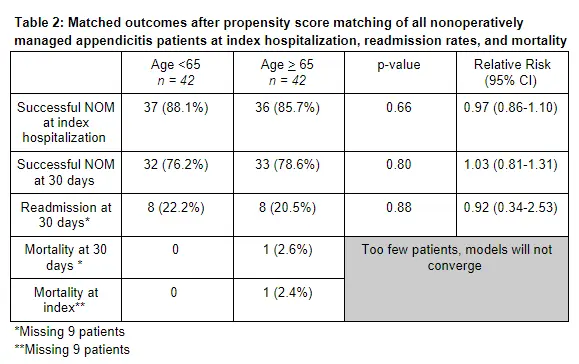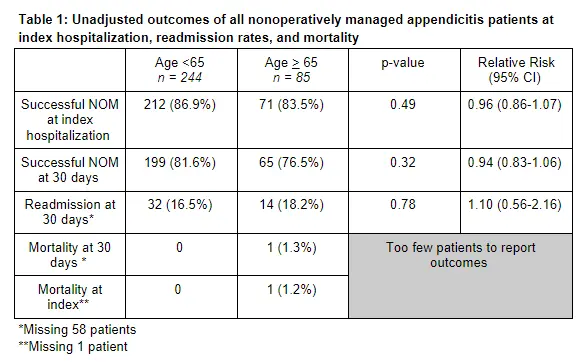Nonoperative Management of Appendicitis in the Elderly
Author(s):
Briana Britton; Mandi Roberts; Eric Campion; Renaldo Williams; Daniel VanDerPloeg; Fredric Pieracci; Angela Sauaia; Barry Platnick; Ernest Moore; Sany Thomas; Magdalene Brooke Sanchez; Alex Morton; D. Yeh, MD
Background:
Nonoperative management (NOM) of appendicitis is becoming increasingly accepted worldwide and the US elderly population is increasing.
Hypothesis:
We hypothesized the rates of NOM in elderly (age>65) appendicitis patients would be higher than younger (age<65) appendicitis patients. Additionally we sought to compare NOM success rates between both age groups.
Methods:
In this post hoc analysis of the EAST MUSTANG appendicitis study, the primary endpoint was success of NOM, defined as antibiotic treatment and/or percutaneous drainage. Secondary outcomes included 30-d NOM success rate, hospital readmissions, and mortality. Propensity score matching (PSM) based on enrollment site and known risk factors was utilized to compare the two age groups.
Results:
The median age of the younger group is 35 (26-48) years old, and the median age of the older group is 71 (68-77) years old. Compared to younger subjects, elderly subjects had increased comorbidities, more prior surgeries, longer duration of symptoms, and more complicated appendicitis on imaging. On initial presentation, older patients were more likely to be managed nonoperatively than their younger counterparts (23.3% vs. 7.6%). In both unadjusted and PSM analyses, older patients managed nonoperatively did not significantly differ from their matched counterparts in terms of successful outcomes (Tables 1 and 2).


Conclusions:
Elderly patients with appendicitis 1) significantly differ from younger patients regarding risk factors, clinical presentation, and imaging findings; 2) are more often managed by NOM; and 3) have similar NOM clinical outcomes after adjusting for risk factors.

